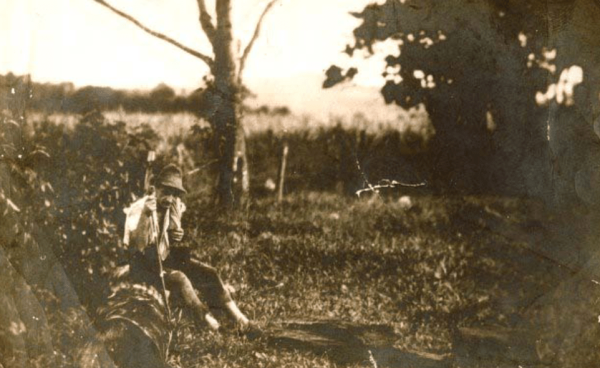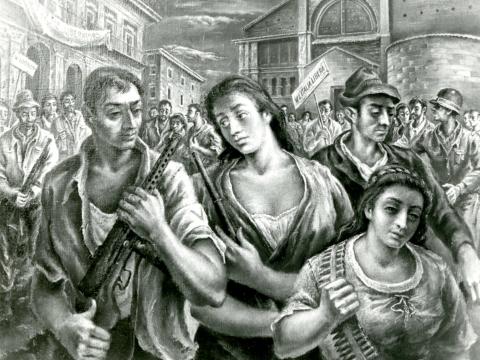A short article on the life and murder of Italian-Australian anarchist Francesco Fantin.

Francesco Giovanni Fantin was an Italian anarchist who migrated to Australia in 1924. Less than twenty years later, in November 1942, he was murdered by a fellow detainee in internment Camp 14A, Loveday, South Australia. Born in 1901 in the small town of San Vito in Northern Italy, Francesco Fantins life was exemplary of a number of migrant anarchists to Australia and their efforts to continue the anti-fascist and workers struggle abroad.
In Francescos youth he followed his father and worked in a textile mill for a regional capitalist. They became members of the Federation of Italian Textile Workers and participated in the national general strikes of 1921. Fantin even became a member of the Schio ‘Red Guards’ during the Biennio Rosso, coming into conflict with strike breakers and local fascists. He and his brothers were radicalised by their workplace experiences and conflicts with military authorities. When the brothers met the anarchist, Francesco Carmagnola in their hometown, Fantins political convictions became more pronounced.
Following the failure of the factory occupations at the height of the Biennio Rosso, the government and nascent fascists moved to crush the nation's large and militant anarchist and syndicalist movements. Under significant threat of violence, the Fantin brothers and Carmagnola made their way to Australia.
Francesco's older brothers and Carmagnola arrived in Australia in 1923. Fantin followed, arriving in Melbourne aboard the Re d’Italia on the 27th of December, 1924. He immediately made his way north to Ingham in Queensland, where he joined the others working as a sugarcane cutter. The region boasted a sizable presence of Italian migrants, including an anarchist group established by the Danesi brothers, Luigi and Costante.
In the decades to come, the Fantin brothers and Carmagnola would move back and forth between Victoria and far North Queensland. Carmagnola even played a significant role in the 1934 Queensland Cane Cutters strike, which defied Australian Workers Union leadership and took action over workers exposure to ‘Weils disease.’ During the strike workers drove around the district in lorries, overturning trucks carting cane to the mills.
It is possible that Francesco Fantin participated in the strike, although it is unclear. He often moved back and forth between Ingham in Queensland and Geelong in Victoria, where he lived on Edols Street and worked at the Federal Mills. A police report on ‘Frank Fantin’ noted that he ‘attempted to speak to his co-workers of his anarchist ideals’ and ‘make propaganda.’ But he was somewhat marginalised by language barriers, certainly as someone considered barely literate, and he generally lived a quiet life.
However Fantin was active in the Australian anti-fascist movement, at least so far as it pertained to the Italian migrant community. Italian migrants established anti-fascist organisations across the country; Sydney, Melbourne and Perth were obvious bases, but Lithgow, Ingham, Broken Hill and Griffith also sported significant Italian anti-fascist organisations. During the 20’s, significant numbers were considered to be anarchists, although these numbers dwindled as more and more radicals joined the Communist Party.
Italian anarchists published a paper titled Il Risveglio (The Reawakening) which declared ‘it is necessary to devote all our physical and intellectual forces in order that the proletariat be well prepared to surmount every obstacle which may be in our path, in order to triumphantly reach our goal, that is Anarchy!’ Though this paper was declared illegal in 1927, it was quickly seceeded by La Riscossa (The Revolt), an anti-fascist publication edited by the anarchists. La Riscossa circulated not only local content, but articles by classic Italian anarchists like Errico Malatesta and Pietro Gori. The paper reached a substantial audience, with over 3000 subscribers at its peak, including those abroad as far as South Africa and Uruguay.
La Riscossa was published from Melbourne, where Fantin and Carmagnola had established the Matteotti Club as a community space near Trades Hall, adorned with a red flag flying. Australian authorities kept a close eye upon the Italian migrant community, often sharing intelligence with the fascist Italian Ministry of the Interior. The Italian consulate in Australia kept detailed lists of anti-fascists Italians active in Australia, and did its best to harass them and their families. Despite this, the Matteotti Club managed to send significant financial support back to Italy, even helping fund Malatestas efforts to continue the underground anarchist press in fascist Italy.
From this intelligence we also know that Fantin was subscribed to Errico Malatesta's paper Pensiero e Liberta (‘Thought and Freedom’). Furthermore, he was on a list of ‘contacts’ of Camillo Berneri, considered the leading intellect of the Italian anarchist movement. While we do not know the exact details of Fantin's political views, it seems likely he was sympathetic to the anarchist-communist, syndicalist and pro-organisationalist views, particularly if he was known to Berneri. These positions most likely contributed to the Italians' isolation from the local Australian anarchist movement, which was often hopelessly individualist. He was certainly considered a capable activist, acknowledged in several police reports as a leader amongst Italian anarchist exiles.
As the Second World War loomed larger, Fantin appears to have spent more and more time in Geelong. It is unknown, though it is possible, he was involved in local anti-fascism, as there were deliberate attacks by fascists on the offices of the Communist Party on Ryrie Street.
When Australia announced it was going to war on the 9th of September, 1939, Italian migrants became considered a public threat. Within days, the Australian Aliens Registration Central Bureau received erroneous information that Fantin was a ‘fascist’ active around Cairns. The tip came in the form of an anonymous letter that claimed ‘Fantini…has expressed his hatred of England and Englishmen. [He] is particularly cunning and a most crafty type.’
Fantin registered as an ‘alien’ at Edmonton Police Station in Queensland on the 7th of October, 1939 and was issued registration certificate No. Q. 18117. An Edmonton police report on Fantin noted that ‘he is a good honest worker…when not speaking of Anarchy.’ However a later report considered him a ‘rabid Communist who for a number of years [has] actively spread Communist propaganda amongst sugar workers in North Queensland.’
Though he was originally identified by the misinformation as a fascist, the police also reported him as both an Anarchist and a Communist, all at once. Whatever his views, the military ultimately considered him ‘definitely opposed to Democracy.’
Despite the confusion, little was needed to justify Fantin's detainment. He was arrested in the first wave of mass, rather than targeted, incarcerations of Italian ‘aliens’ on the 14th of February 1942 and placed in Gaythorne Internment camp in Queensland. Two officers searched a room he had occupied in Edmonton, finding a number of books containing notes and poetry, letters, a pamphlet by Karl Marx, a ‘multi-coloured’ handkerchief and a photograph of anarcho-syndicalist leader Buenaventura Durruti.
In March, Fantin was moved to Loveday Internment Camp 14A in South Australia. Australian authorities divided prisoners in internment camps according to nationality, not political conviction. Therefore Italian, German and Japanese prisoners were separated, however fascists and left-wingers were intermixed. Furthermore a complicated system of ‘camp leaders’ meant prisoners helped run the administration meant that the far-right dominated the space. In 14A, one Doctor Francesco Piscitelli, a fascist fanatic, was camp leader. Every night, Italian prisoners were forced to attend lectures on the virtues of fascism before sundown.
Fantin's politics were known to the other prisoners, originally a majority of whom were not actually exceptionally political. After a second transfer to Loveday of nearly 300 more internees, the vast majority were now convinced fascists. Fantin suffered abuse at their hands. One night an inmate entered his tent, choked and beat him and threatened to murder the anarchist. He reported the incident to apparently sympathetic staff, but nothing was done.
On the 16th of November, 1942, Giovanni ‘Bruno’ Casotti, an Italian fascist from Western Australia approached Fantin from behind while Francesco was drinking from a water tap. He struck Fantin across the back of the head with a large piece of timber, and continued to kick his body as he fell. Fantin was rushed to Barmera Base hospital, but died shortly thereafter from his head injury.
Most witnesses were terrified of speaking out in an atmosphere of intimidation and fascist violence. While the fascists claimed that Fantin had fallen and hit his head, it was apparent that this was a case of deliberate murder. Casotti was eventually charged with manslaughter, and given a two year sentence. Following Fantins death, nationwide agitation from anti-fascists resulted in a more careful internment process, separating fascists and anti-fascists, and the releasing of a number of anti-fascists altogether.
After his death Francesco Fantin became something of a martyr for the anti-fascist cause in Australia, eliciting sympathy from fellow anarchists, communists and liberals alike. Sadly, despite their contributions the class struggle principles of Fantin and the Italian anarchists, much like that of the Bulgarian and Spanish exiles, remained marginalised from the Australian radical movement.
Fantin's last days were tragic, confined to a camp with those whose political views he had spent his entire life fighting. In his camp diary Francesco kept notes and wrote poems, a tragic example lamenting;
“Dreams? The bitter reality of finding myself always here among this infected mass of war. And among few with righteous consciences, in these last twenty years, in these times of dictators and dictatorships, the human species full of fevers seems mad.'”






Comments
Great article thanks for…
Great article thanks for writing! Just one small thing, you mention La Riscossa, then in the next paragraph mention La Riccasso – I'm assuming that's a typo?
Steven. wrote: Great article…
Yep! Thanks for pointing that out.